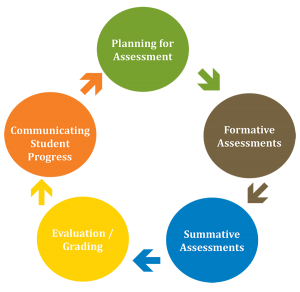
Principle #9
Communicating student learning must be clear, transparent, and ongoing, with a focus on performance standards-based language and meaningful descriptions, collections, and demonstrations of student learning.
“When we give students grades – when we evaluate them – we want to grade them on what they have learned – grades are based on evidence gleaned from ongoing authentic assessment…work samples, student talk, performances, artifacts…we evaluate and give grades ONLY after students have had time to internalize the strategies and skills we have taught and we base grades on a substantial body of evidence that stands as proof of learning and current understandings.”
—Stephanie Harvey and Harvey Daniels, 2009
Effective communication between the home and the school is central to student success and should occur on a regular basis, inside and outside of the traditional reporting periods. The goal of communicating student learning is to ensure that communication between home and school is effective and timely, so that parents are well informed about their child’s progress and are able to support their child’s learning where needed.
Throughout each reporting period, teachers gather and record assessment and evaluation data regarding students’ level of performance in relation to criteria established for each learning standard. Traditional reporting provides parents with up to date information on student learning and with a snapshot of the student’s proficiency in the essential knowledge and skills associated with the discipline/course of study.
Prior to issuing report cards, teachers review the assessment data and judge each student’s overall performance trend for each standard based on information collected through learning activities over an instructional period. Many teachers may set up their gradebooks to group the standards. This promotes clarity around what is actually being assessed.
In North Vancouver, the overarching goals for communicating student learning are to communicate student progress meaningfully to parents. This can be achieved by providing descriptive feedback on student progress on the learning standards (curricular competencies and content), articulating the student’s next steps for learning and providing meaningful, relevant descriptions, and concrete evidence/artifacts that show learning.
Teachers may communicate to parents with report cards, but also:
- Parent-teacher conferences (in person, or phone)
- Progress reports
- Notifications via school app
- Digital portfolios
- Portal classes
ASSESSMENT CYCLE

TRY THIS
Click here for ideas to try in the classroom
1) Provide regular feedback that is clear, transparent, and ongoing.
2) Avoid educational jargon.
3) Include students in parent, teacher, student conferences.
4) Set up gradebook by learning standards categories.
5) Analyze the trends of student performance.
6) Use the most consistent or most recent evidence to support the grade given to a student.
7) Use the “snapshot” technique, which considers a grade to be a picture of where students’ skills are at the time of reporting, not the beginning of a term.
8) Consider how a body of evidence (tied to Learning Standards) + professional judgement = grade
WATCH THIS
Click here to watch related video content
Student Involvement in and Understanding of Assessment and Grading
Ken O’Connor explains that if students are going to achieve–and achieve well–they need to understand the assessment and grading process. Students need to be involved in the process.
READ THIS
Click here for additional reading suggestions
To learn more, check out these texts:
- Further information on Communicating Student Learning in North Vancouver.
- The British Columbia Ministry of Education provincial regulations regarding Communicating Student Learning.
- Cooper, Damian. (2007). Talk about assessment: Strategies and tools to improve learning. Nashville, TN: Thomas Nelson Incorporated.
- O’Connor, Ken (2017). How to grade for learning: Linking grades to standards. Thousand Oaks, CA 91320: SAGE Publications
- Brookhart, Susan M. (2017). How to use grading to improve learning. Bloomington, IN: Solution Tree Press.
- Schimmer, Tom. (2016). Grading from the inside out. Bloomington, IN: Solution Tree Press.
- Winger, T. (2005): Grading to communicate. Educational Leadership v63(n3), p61-65. Retrieved at ERIC database (EJ745459) www.eric.ed.gov.
